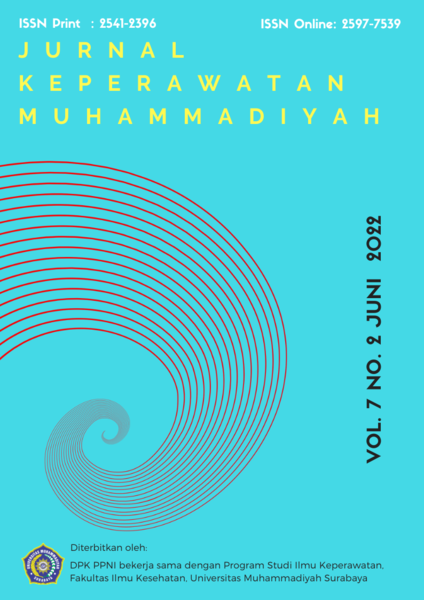Pengaruh Mc Kenzie Exercise Terhadap Penurunan Nyeri Pada Pasien Low Back Pain Myogenic Di Klinik Pandaan Medika
DOI:
https://doi.org/10.30651/jkm.v7i2.11399Keywords:
Mc Kenzie exercise, pain, myogenic low back pain, Visual Analogue ScaleAbstract
Objective:Â Myogenic low back pain is pain in the lower back in the absence of neurological disorders that occur due to tissue damage to the tendons. Low back pain due to musculoskeletal disorders can cause pain, muscle cramps, and muscle imbalance, which can lead to decreased stability of the abdominal muscles, back pain, limited mobility of back pain, changes in posture, and disability in these patients. Treatment of myogenic back pain can be overcome with non-drug therapy, and in cases of low back pain caused by muscle stiffness, it is recommended to do physical therapy to train the back muscles. Physiotherapy is given by doing Mc Kenzie exercises. This study was conducted to determine the effect of Mc kenzie exercise on reducing pain scale in patients with myogenic low back pain.Methods:Â This type of research is pre-experimental research with single group design before and after testing. This research was conducted at Pandaan Medika Clinic. The subjects of the study were 15 patients who met the criteria determined by the researcher. The data were analyzed using the Wilcoxon Signed Rank Test nonparametric statistical method. The study was conducted from September 10, 2021 to October 15, 2021. The pain scale was measured using the Visual Analog Scale (VAS) before and after training. Subjects did the Mackenzie exercise three times a week for one month.
Results:  The statistical test obtained, there was a decrease in the pain scale on the administration of Mc Kenzie exercise using the Wilcoxon test at a significance level of p < 0.05 The result was that p = 0.001 < (0.05) which means Ho is rejected and Ha is accepted.
Conclusion: This shows that Mc kenzie exercise has a significant effect on changes in the level of pain scale in patients with low back pain at the Pandaan Medica Clinic.References
Pearce, E. C. (2014). Anatomi dan Fisiologi Untuk Paramedis. Jakarta: Gramedia Pustaka Utama.
Lelengboto, Fresa. (2017). Hubungan Antara Posisi Duduk dengan Keluhan Nyeri Punggung Bawah pada Pengemudi Angkutan Kota Trayek Malalayang – Karombasan Kota Manado. Fakultas Kesehatan Masyarakat Universitas Sam Ratulangi Manado.
Kusumawati, R.Y, Wahyono. Y. 2015. Latihan Core Stability dan William’s Flexion Dalam Menurunkan Nyeri, Peningkatan Keseimbangan dan Kemampuan Fungsional. Politeknik Kesehatan Surakarta Jurusan Fisioterapi
Mochamad Bahrudin, 2017. Patofisiologi Nyeri (Nyeri). Naskah Publikasi, Vol 13 Nomor 1.
Moore KL, Dalley AF, Agur AMR, Moore ME.2013. Anatomi Berorientasi klinis.Edisi ke-5. Jakarta: Erlangga.
Notoadmojdo, 2012. Metodelogi Penelitian Kesehatan. Jakarta: Rineka Cipta
Pratiwi, Putri Ayu, 2020. Pengaruh Mc. Kenzie Exercise Terhadap Penurunan Nyeri Low Back Pain (LBP) Miogenik pada Kuli Bangunan di PT Garuda Bangkit Jaya Kota Madiun.
Farnianti, T. 2015. Kombinasi Mc. Kenzie dan William Flexion Exercise Tidak Berbeda dengan Pilates Exercise dalam Meningkatkan Keseimbangan Statis dan Fleksibilitas Trunk pada Wanita Dewasa. (Tesis). Denpasar: Program Pasca Sarjana Universitas Udayana.
Saputri, O. D. Pengaruh Core Stability Exercise dan MC Kanzie Exerciseterhadap peningkatan Aktivitas Fungsional pada Penjahit denganKeluhan Nyeri Punggung Bawah (NBP) Miogenik di Desa Tambong kabupaten Klaten.Surakarta: Universitas Muhammadiyah
Raco, J. R. (2010). Metode Penelitian Kualitatif Jenis, Karakteristik, Dan Keunggulannya. Jakarta: PT. Grasindo.
Snell, R.S. 2012. Anatomi Klinik Berdasarkan Sistem. Di alih bahasakan oleh Suguharto L. Jakarta: EGC.
Harnovinsah. (2019). Modul Metode Pengumpulan Data. Metodologi Penelitian. 3-5.
Downloads
Published
Issue
Section
License
- Penulis tetap memegang hak atas karyanya dan memberikan hak publikasi pertama kepada jurnal ini yang secara simultan karya tersebut dilisensikan di bawah:Â Creative Commons Attribution-ShareAlike 4.0 International (CC BY-SA 4.0)













